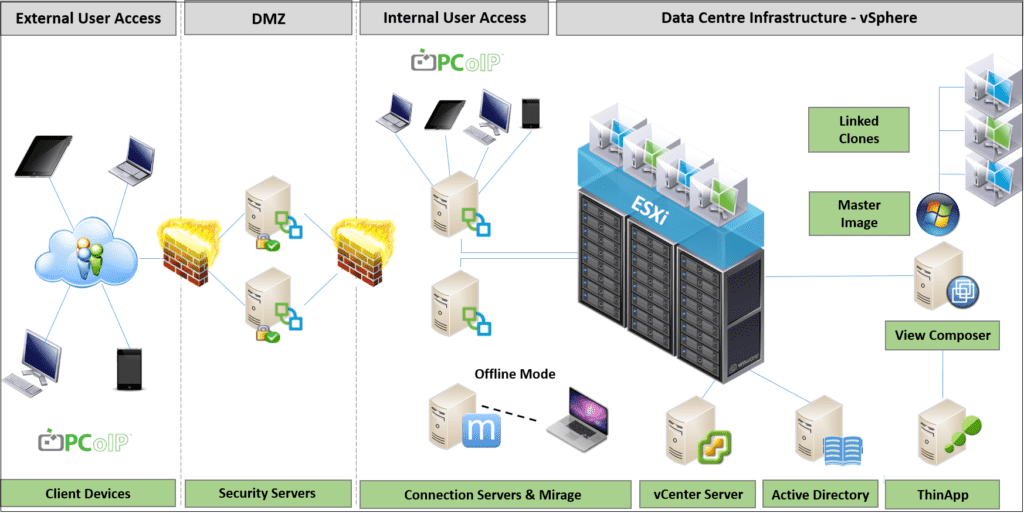VMware Horizon provides a virtual desktop solution and an enterprise-class application-publishing solution.
Horizon features and components, such as the Blast Extreme display protocol, instant-clone provisioning, VMware App Volumes application delivery, and VMware User Environment Manager, are also integrated into Remote Desktop Session Host (RDSH) sessions to provide a seamless user experience and an easy-to-manage, scalable solution.
VMware, the recognized leader in VDI, has now extended its expertise into the realm of Remote Desktop Session Host application publishing with its introduction of Horizon Hosted Applications that can run on the reliable, WAN-optimized PC-over-IP (PCoIP) protocol. By incorporating Hosted Application functionality within Horizon, customers have a more manageable, affordable, and feature-rich choice in meeting organizations’ need for an efficient virtual desktop environment.
True SSO:
Streamlines the end-to-end login experience. Users logging in and authenticating via VMware Identity Manager would previously be presented with a second login prompt to access their Windows desktop, using their AD credentials. True SSO seamlessly bypasses this secondary login request for users who have already authenticated via VMware Identity Manager, using a short-lived Horizon virtual certificate, enabling a password-free Windows login that brings them immediately to their desktop, for a secure, simplified, and faster overall experience.
Multi-User Interface:
Users can access their virtual desktop through LAN or WAN securely, and be using multiple types of client interfaces using RDP or PCoIP protocols such as:
- Zero Client.
- Thin Client.
- Horizon Client for Android.
- Horizon Client for Windows.
- Horizon Client for Linux.
- Horizon Client for MAC.
- Horizon Client for iOS.
- Horizon Client for Chrome OS.
- VMware Horizon HTML Access.
Features and Benefits:
Manageability
Provisioning desktops and applications for end users is a quick process. No one is required to install apps one by one on each end user’s physical PC. End users connect to a remote application or a remote desktop complete with applications. End users can access their same remote desktop or application from various devices at various locations.
Hardware Independence
Remote desktops and applications are hardware-independent. For example, because a remote desktop runs on a server in the data center and is only accessed from a client device, a remote desktop can use an operating system that might not be compatible with the hardware of the client device. For that
Remote desktops or PCoIP sessions run on PCs, Macs, thin clients, and PCs that have been repurposed as thin clients, tablets, and phones. The remote applications run on a subset of these devices.
New device support is added quarterly.
Also, if you use the HTML Access feature, end users can open a remote desktop or application inside a browser, without having to install any client application on the client system or device.
Virtual Dedicated Graphics:
Horizon with Blast 3D breaks the tethers of the physical workstation. Virtual desktops now deliver immersive 2D and 3D graphics seamlessly rendered on any device, accessible from any location. Power users and designers can collaborate with global teams in real time while organizations increase workforce productivity, save on costs and expand user capabilities, and more.
Refresh, Recompose and Rebalance:
In case if the vendor logged in to any virtual desktop after that, they completed the tasks entrusted to them.
In that case, we can rebuild the virtual desktop in a time not exceeding the minute and then the virtual desktop is ready for use again for the same vendor or another vendor.
Who can access Horizon desktop, and from where?
Everyone can access his virtual desktop from anywhere.
- End User
- Vendor
- VIP Users
- IT Team
Thanks.



